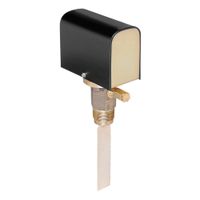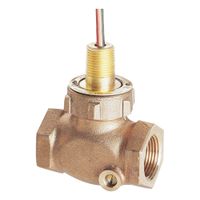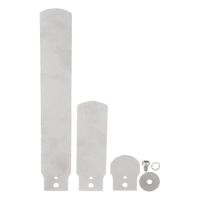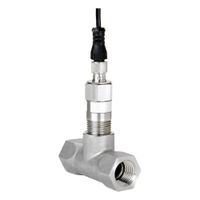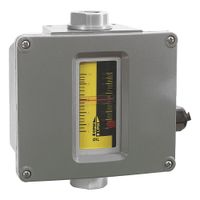Call +(254) 703 030 000 / 751 483 999 / 721 704 777
- Home
- Pumps
- Flow Level Measurement Controls
- Flow Switches
Flow Switches
Flow switches detect and control media, such as gases, liquids, or vapors. Switches start in a neutral position, such as vertical, extended, or hot. In the neutral position, the switch's circuit is closed. Flowing media moves or cools the sensor, opening the circuit. In low or no flow conditions (or .....Read More
Frequently Asked Questions
What is a flow switch and how does it work?
A flow switch is a device used to monitor the flow of liquid or gas through a system. It ensures that the flow rate is within a specified range and can trigger actions if the flow deviates from this range. Flow switches are critical in various applications, including HVAC systems, industrial processes, and water treatment plants, to prevent damage or inefficiency caused by inadequate or excessive flow.
Flow switches operate using different mechanisms, depending on the type and application. Common types include paddle, thermal, and electronic flow switches.
1. **Paddle Flow Switch**: This type uses a paddle or vane placed in the flow path. As fluid moves, it pushes the paddle, which is connected to a mechanical or magnetic sensor. When the flow rate changes, the paddle's position shifts, triggering a switch that can activate alarms, shut down equipment, or initiate other control actions.
2. **Thermal Flow Switch**: This type relies on the principle of heat transfer. It uses a heated sensor and a temperature sensor. As fluid flows over the heated sensor, it cools down, and the rate of cooling is proportional to the flow rate. The switch activates when the flow rate falls below or exceeds a set threshold.
3. **Electronic Flow Switch**: These use electronic sensors to detect flow changes. They often employ ultrasonic or electromagnetic principles to measure flow rate without any moving parts, offering high precision and reliability.
Flow switches are essential for maintaining system integrity, safety, and efficiency. They can be configured to send alerts, shut down systems, or trigger backup processes, ensuring that operations continue smoothly and safely.
What are the different types of flow switches?
Flow switches are devices used to monitor and control the flow of liquids, gases, or steam in a system. The different types of flow switches include:
1. **Paddle Flow Switches**: These switches use a paddle or vane that is displaced by the flow of fluid. The movement of the paddle actuates a switch mechanism. They are commonly used in water and HVAC systems.
2. **Piston Flow Switches**: These switches have a piston that moves in response to fluid flow. The piston's movement triggers a magnetic or mechanical switch. They are suitable for low-flow applications and are often used in hydraulic and lubrication systems.
3. **Thermal Dispersion Flow Switches**: These switches use the principle of thermal dispersion, where a heated sensor is cooled by the fluid flow. The rate of cooling is used to determine the flow rate. They are ideal for detecting low flow rates in clean liquids and gases.
4. **Turbine Flow Switches**: These switches use a turbine rotor that spins with the flow of fluid. The rotational speed of the turbine is used to actuate a switch. They are used in applications requiring precise flow measurement.
5. **Ultrasonic Flow Switches**: These switches use ultrasonic waves to detect the flow of fluid. The time it takes for the waves to travel through the fluid is used to determine the flow rate. They are non-intrusive and suitable for a wide range of fluids.
6. **Variable Area Flow Switches**: Also known as rotameters, these switches have a float that rises and falls with the flow of fluid in a tapered tube. The position of the float is used to actuate a switch. They are simple and reliable for visual flow indication.
7. **Electronic Flow Switches**: These switches use electronic sensors to detect flow and are often integrated with digital displays and control systems. They offer high precision and are used in advanced industrial applications.
How do paddle flow switches differ from piston flow switches?
Paddle flow switches and piston flow switches are both devices used to monitor and control the flow of liquids in a system, but they operate on different principles and are suited for different applications.
Paddle flow switches use a paddle or vane that extends into the flow path. When fluid flows through the pipe, it pushes against the paddle, causing it to move. This movement is mechanically linked to a switch mechanism that opens or closes an electrical circuit, signaling the presence or absence of flow. Paddle flow switches are typically used in applications with larger pipe diameters and are suitable for detecting flow in systems with relatively low flow rates. They are simple, cost-effective, and can handle a wide range of fluid types, including those with particulates.
Piston flow switches, on the other hand, use a piston mechanism housed within a chamber. As fluid flows through the chamber, it exerts pressure on the piston, causing it to move. This movement actuates a switch, similar to the paddle flow switch. Piston flow switches are generally used in applications with smaller pipe diameters and are ideal for detecting low flow rates with high precision. They are often used in clean fluid applications, as particulates can obstruct the piston's movement. Piston flow switches are more sensitive and can provide more accurate flow detection compared to paddle flow switches.
In summary, paddle flow switches are better suited for larger pipes and systems with particulates, while piston flow switches are ideal for smaller pipes and clean fluid applications requiring precise flow detection.
What are the advantages of thermal-dispersion flow switches?
Thermal-dispersion flow switches offer several advantages:
1. **No Moving Parts**: These switches have no moving parts, reducing wear and tear, minimizing maintenance, and enhancing reliability and longevity.
2. **High Sensitivity**: They can detect very low flow rates, making them suitable for applications requiring precise flow monitoring.
3. **Wide Range of Applications**: Suitable for both liquids and gases, they can be used in various industries, including chemical, water treatment, and HVAC systems.
4. **Durability**: Constructed from robust materials, they can withstand harsh environments, including high temperatures and corrosive substances.
5. **Low Pressure Drop**: Their design ensures minimal obstruction to flow, resulting in a low pressure drop across the switch.
6. **Versatility**: They can be used in a wide range of pipe sizes and configurations, offering flexibility in installation.
7. **Energy Efficiency**: Consuming minimal power, they are energy-efficient, which is beneficial for continuous operation.
8. **Easy Installation and Calibration**: Typically easy to install and calibrate, they reduce downtime and labor costs.
9. **Real-time Monitoring**: Provide continuous monitoring of flow conditions, allowing for immediate response to changes in flow.
10. **Cost-effective**: Over time, their durability and low maintenance requirements can lead to cost savings.
11. **Safety**: By ensuring proper flow rates, they help prevent equipment damage and ensure safe operation of systems.
12. **Customizable**: Many models offer adjustable settings to tailor performance to specific application needs.
These advantages make thermal-dispersion flow switches a preferred choice for many industrial and commercial applications.
How do you install a flow switch in a system?
1. **Select Location**: Choose a location in the piping system where the flow switch can accurately detect flow changes. Ensure it is away from turbulence, bends, or valves.
2. **Shut Down System**: Turn off the system and relieve pressure to ensure safety during installation.
3. **Prepare Piping**: Cut the pipe at the selected location. Ensure the cut is clean and free of burrs.
4. **Install Fittings**: Attach the appropriate fittings (e.g., T-joint or saddle) to accommodate the flow switch. Ensure they match the pipe material and size.
5. **Mount Flow Switch**: Insert the flow switch into the fitting. Ensure the flow direction arrow on the switch aligns with the system's flow direction.
6. **Secure Connections**: Tighten all connections using appropriate tools. Use thread sealant or Teflon tape if necessary to prevent leaks.
7. **Electrical Wiring**: Connect the flow switch to the control system. Follow the manufacturer's wiring diagram. Ensure connections are secure and insulated.
8. **Test Installation**: Restore system pressure and check for leaks. Test the flow switch operation by varying flow rates and observing the switch response.
9. **Calibration**: If required, calibrate the flow switch according to the manufacturer's instructions to ensure accurate operation.
10. **Documentation**: Record the installation details, including location, settings, and any calibration data for future reference.
11. **Safety Check**: Ensure all safety protocols are followed, and the system is operating correctly before resuming normal operations.
What are common applications for flow switches?
Flow switches are critical components in various industries, serving to monitor and control the flow of liquids and gases. Common applications include:
1. **HVAC Systems**: In heating, ventilation, and air conditioning systems, flow switches ensure the proper flow of air and coolant, preventing overheating and ensuring efficient operation.
2. **Industrial Process Control**: Flow switches are used to monitor the flow of liquids and gases in manufacturing processes, ensuring that machinery operates within specified parameters to maintain product quality and safety.
3. **Water Treatment Plants**: They help in monitoring the flow of water and chemicals, ensuring that treatment processes are functioning correctly and efficiently.
4. **Fire Protection Systems**: In sprinkler systems, flow switches detect water flow, triggering alarms and ensuring that fire suppression systems activate when needed.
5. **Pumping Systems**: Flow switches protect pumps from running dry by ensuring that there is adequate flow, thus preventing damage and prolonging pump life.
6. **Oil and Gas Industry**: They are used to monitor the flow of oil and gas through pipelines, ensuring safe and efficient transport and processing.
7. **Chemical Processing**: Flow switches help in maintaining the correct flow rates of chemicals, which is crucial for safety and product consistency.
8. **Cooling Systems**: In industrial and electronic cooling systems, flow switches ensure that coolant is flowing properly to prevent overheating and equipment failure.
9. **Food and Beverage Industry**: They are used to monitor the flow of ingredients and products, ensuring consistency and quality in production.
10. **Marine Applications**: Flow switches are used in bilge systems and engine cooling systems to ensure proper operation and safety at sea.
How do you troubleshoot a flow switch that is not working properly?
To troubleshoot a malfunctioning flow switch, follow these steps:
1. **Visual Inspection**: Check for physical damage, corrosion, or debris around the switch. Ensure the switch is properly mounted and aligned.
2. **Power Supply**: Verify that the switch is receiving the correct voltage. Use a multimeter to check the power supply and ensure connections are secure.
3. **Wiring and Connections**: Inspect all wiring for signs of wear, loose connections, or breaks. Tighten any loose connections and replace damaged wires.
4. **Flow Conditions**: Confirm that the fluid flow is within the switch's operating range. Check for blockages or leaks in the system that might affect flow.
5. **Switch Settings**: Review the switch settings to ensure they are configured correctly for the application. Adjust the setpoint if necessary.
6. **Testing the Switch**: Manually actuate the switch if possible to see if it responds. Use a multimeter to test continuity across the switch terminals when actuated.
7. **Sensor Element**: Inspect the sensor element for fouling or damage. Clean or replace the sensor if necessary.
8. **Calibration**: Recalibrate the switch according to the manufacturer's instructions to ensure accurate operation.
9. **Environmental Factors**: Consider environmental conditions such as temperature, pressure, or vibration that might affect switch performance.
10. **Consult Documentation**: Refer to the manufacturer's manual for specific troubleshooting tips and specifications.
11. **Replacement**: If the switch is still not functioning after troubleshooting, consider replacing it with a new unit.
12. **Professional Assistance**: If issues persist, consult a professional technician or the manufacturer for further assistance.
